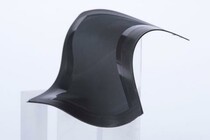Draper Aids Human Climbers with Technology Inspired by Geckos
CAMBRIDGE, MA – Draper has invented a system for wall-climbing using pistons, suction cups and a gecko skin-like surface that is small, compact and can enable a person to climb glass and other surfaces that would otherwise be very challenging to scale. The wall-climbing device and several others like it are products of Draper’s participation in the Z-Man program, a research initiative sponsored and funded by the Defense Advanced Research Projects Agency (DARPA).
The Z-Man program has developed a variety of devices to help soldiers scale walls of varying type (from smooth glass to rough concrete block) without the use of ropes or ladders. By its nature, climbing a wall is a challenge for humans given their generally weak upper body strength and consequently must carry or use equipment like ladders that can be heavy, cumbersome and limiting to mobility.
Draper has changed that by developing lightweight climbing systems that the user carries with them as they climb, reducing the need for bulky equipment and greatly increasing mobility. For inspiration in developing its latest wall-climbing technologies, Draper turned to the gecko. Key to the gecko’s ability to climb is the unique structure of the pads on its feet. Composed of a two-fold mechanism that involves microscopic tendrils called setae and the spatulae that sit at their end, the gecko can adhere itself to nearly any surface by means of van der Waals forces.
The Draper team used biomimetic design – an engineering method that mimics or copies how nature solves problems – to develop a reversible adhesive elastomer. The MicroHold material clings to surfaces the same way that a gecko’s feet do. In 2012, Draper used the MicroHold material to demonstrate the first known human climbing of a glass wall with climbing devices inspired by geckos.
“That was amazing, but we are only at the very beginning of exploring the true design potential of biomimetic climbing,” said William McFarland, leader of the Delivery Systems Group at Draper. “Our newest climbing system combines the gecko-inspired adhesive with a suction element to achieve better and more robust performance than either could alone.”
The new hybrid climbing device is made up of two hand-held units featuring pads covered with the MicroHold material. Surrounding the pads are suction cups linked by pistons to two stirrups secured to the climber’s feet. With downward pressure on the stirrup, the unit adheres to the surface. As the climber lifts a leg, the stirrup rises and the vacuum is released, allowing the next step in the climb.
The technologies, when integrated in Draper’s device, work in concert to enable a person to travel up and across just about any smooth and nonporous surface – such as glass or metal – vertical or horizontal. The device’s size and mobility enables a climber to scale surfaces and climb in conditions that most wall-climbing solutions cannot match.
Under the Z-Man program, Draper developed and delivered two other solutions, including SpineHold and MagnetoHold, which benefited from Draper’s cross-discipline team of engineers, scientists and designers who have expertise in Materials Science, Mechanical Engineering and Microsystems.
Draper’s SpineHold system supports reversible attachment to rough, flat surfaces such as concrete block. Arrays of insect-inspired microspines hook into surface asperities (“nooks and crannies”) and distribute the climber’s weight so that each microspine holds only a portion of the total. The microspine portion of the program culminated with a first-of-a-kind demonstration enabling a human to climb up a concrete block wall, which took place in April 2010.
Draper’s MagnetoHold system supports weight suspended from any magnetic surface. When engaged, MagnetoHold acts as a super-strong magnet that can support hundreds of pounds. When disengaged, MagnetoHold acts like a refrigerator magnet that easily detaches from the surface. MagnetoHold can be customized for larger or smaller loads as needed.
All of the systems demonstrate “directional adhesion,” which allows the technology to hold the weight of a human while still being easily removed and reapplied to a surface to enable climbing. Further, none of these systems requires power to operate.
Released November 30, 2016







